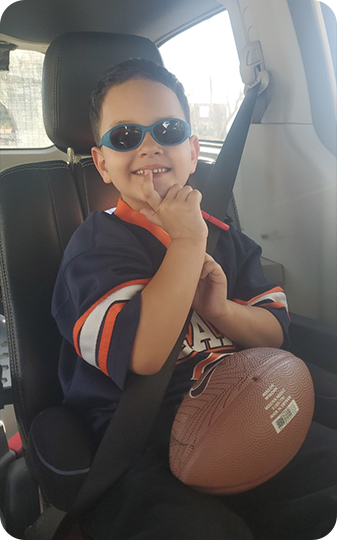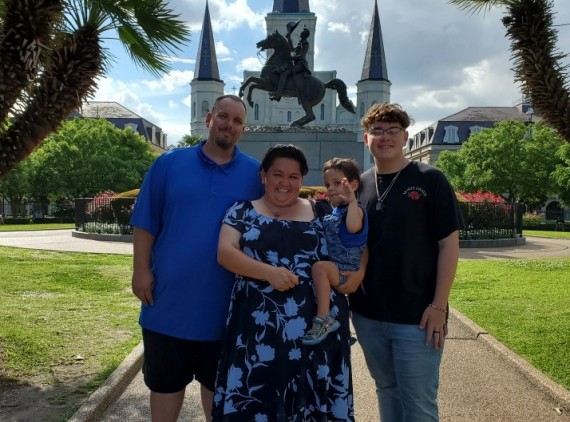Seeing the world through the eyes of a child can make things seem fresh and new. Unless those eyes are clouded by cataracts. For children like 4-year-old Xander who were born with cataracts, the ophthalmology team at Phoenix Children’s can reveal a whole new world.
“Most people develop cataracts when they're older because oxidation in the body causes proteins in the lens to become opaque and no longer clear,” explained Kamran Ahmed, MD, an ophthalmologist at Phoenix Children’s. “Kids usually get cataracts because they're born with a genetic mutation that causes cataracts. They can also get cataracts for other reasons, including trauma, autoimmune diseases, metabolic diseases and some medications.”
In Xander’s case, the condition was part of his family’s health history. Xander’s father, Randall, also had cataracts at birth. His artificial lenses were implanted when he was 7 years old.
The lens of a healthy eye is clear (transparent). It helps focus and transform light into images you can see. A cataract occurs when the protein that makes up the lens becomes cloudy or opaque. When this happens, light cannot pass through the lens, and vision becomes blurry, hazy or completely blocked.
Treatment for cataracts depends on the child’s symptoms, age and general health. For some children, glasses or contact lenses can help them see more clearly. If the cataract is small and doesn’t restrict the child’s vision, the lens may not need to be removed.
Xander’s journey
Xander is a healthy, active – and often loud – little boy, but that hasn’t always been the case, according to his parents. Xander was born with several health challenges: the cataracts in both eyes, autism and structural issues with his ears that affected his hearing. Right from the start, he received care from several facilities. Still, it wasn't until he came to Phoenix Children's for cataract surgery that he started to show improvement.
“If Xander’s doctors said, 'Try this therapy,' I tried that therapy,” said Xander’s mom, Victoria. “Nothing was getting through until we got a referral for an ophthalmologist, which led us to Phoenix Children’s.”
Shortly after becoming a patient at Phoenix Children’s, Xander had cataract surgery with Dr. Ahmed and his team to replace his faulty lenses with clear artificial lenses that allow light to pass through. The difference it made in his life is “a miracle,” according to Victoria.
“What I found striking about Xander's case – and we've seen this in other children, too – was how much his behavior and social interaction improved after his cataract surgery because he was able to see so much better,” said Dr. Ahmed.
Victoria agrees wholeheartedly. “Right now, Xander gets occupational therapy. He gets feeding therapy. He's got speech therapists, and he's gone through classes to learn how to use an augmentative and alternative communication device. Of all the surgeries and care Xander’s had, his eye surgery was the one that made the most difference,” she said.

See the difference with Phoenix Children’s
Phoenix Children’s is one of the few pediatric centers in the United States with the training, expertise and equipment to offer pediatric cataract and refractive surgery. This combination helps ensure the best possible outcome, according to Dr. Ahmed.
Phoenix Children’s can treat various types of cataracts in children, which include:
- Congenital cataracts that are present at birth
- Secondary cataracts that develop because of an illness
- Traumatic cataracts that are caused by an eye injury
- Dislocated lenses and cataracts that are not in the correct position
“The steps of cataract surgery in kids are a little bit different than the steps of cataract surgery in adults. Kids’ tissues are more elastic and behave differently during surgery. Kids can have complications that adults don't usually get,” said Dr. Ahmed. “Managing cataracts after surgery is very important, especially in children. They're still growing, and their eyes are still growing. Their visual system is still developing. We have to make sure that they're not developing complications after surgery.”
Xander’s parents say the difference in their son since his cataract surgery is immediately apparent to anyone who knows him.
“Without the cataract surgery, I don't know where Xander would be. He wouldn't be talking. Now, he's got best friends. He goes to school. He asks for things. He’s potty trained,” said Victoria. “The turning point was the eye surgery because, after that, he came alive. Cataract surgery saved Xander's life.”

